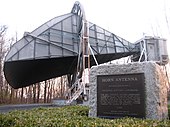Discovery of cosmic microwave background radiation
| Part of a series on |
| Physical cosmology |
|---|
This article includes a list of general references, but it lacks sufficient corresponding inline citations. (January 2018) |
The discovery of cosmic microwave background radiation constitutes a major development in modern
History

By the middle of the 20th century,
In 1941, Andrew McKellar used W. S. Adams' spectroscopic observations of CN absorption lines in the spectrum of a B type star to measure a blackbody background temperature of 2.3 K. McKellar referred to his detection as a "'rotational' temperature of interstellar molecules", without reference to a cosmological interpretation, stating that the temperature "will have its own, perhaps limited, significance".[5]
Over two decades later, working at a
When Penzias and Wilson reduced their data, they found a low, steady, mysterious noise that persisted in their receiver. This residual noise was 100 times more intense than they had expected, was evenly spread over the sky, and was present day and night. They were certain that the radiation they detected on a wavelength of 7.35 centimeters did not come from the Earth, the Sun, or our galaxy. After thoroughly checking their equipment, removing some pigeons nesting in the antenna and cleaning out the accumulated droppings, the noise remained. Both concluded that this noise was coming from outside our own galaxy—although they were not aware of any radio source that would account for it.
At that same time,
When his friend
To avoid potential conflict, they decided to publish their results jointly. Two notes were rushed to the
In 1978, Penzias and Wilson were awarded the
Bibliography
- Aaronson, Steve (January 1979). "The Light of Creation: An Interview with Arno A. Penzias and Robert W. Wilson". Bell Laboratories Record: 12–18.
- Abell, George O. (1982). Exploration of the Universe. 4th ed. Philadelphia: Saunders College Publishing. ISBN 9780030585029.
- Asimov, Isaac (1982). Asimov's Biographical Encyclopedia of Science and Technology. 2nd ed. New York: Doubleday & Company, Inc.
- Bernstein, Jeremy (1984). Three Degrees Above Zero: Bell Labs in the Information Age. New York: Charles Scribner's Sons. ISBN 978-0-684-18170-7.
- Brush, Stephen G. (August 1992). "How Cosmology Became a Science". Scientific American. 267 (2): 62–70. .
- Chown, Marcus (September 29, 1988). "A cosmic relic in three degrees". Bibcode:1988NewSc.119...51C.
- Crawford, A.B.; Hogg, D. C.; Hunt, L. E. (July 1961). "Project Echo: A Horn-Reflector Antenna for Space Communication". The Bell System Technical Journal. 40: 1095–1099. .
- Disney, Michael (1984). The Hidden Universe. New York: Macmillan Publishing Company. ISBN 978-0-02-531670-6.
- Ferris, Timothy (1978). The Red Limit: The Search for the Edge of the Universe. 2nd ed. New York: Quill Press.
- Friedman, Herbert (1975). The Amazing Universe. Washington, DC: National Geographic Society. ISBN 978-0-87044-179-0.
- Hey, J.S. (1973). The Evolution of Radio Astronomy. New York: Neale Watson Academic Publications, Inc. ISBN 978-0-88202-027-3.
- Jastrow, Robert (1978). God and the Astronomers. New York: W. W. Norton & Company, Inc. ISBN 978-0-393-01187-6.
- Kirby-Smith, H.T. (1976). U.S. Observatories: A Directory and Travel Guide. New York: Van Nostrand Reinhold Company. ISBN 978-0-442-24451-4.
- Learner, Richard (1981). Astronomy Through the Telescope. New York: Van Nostrand Reinhold Company. ISBN 978-0-442-25839-9.
References
- ^ doi:10.1086/148307.
- ^ a b Overbye, Dennis (5 September 2023). "Back to New Jersey, Where the Universe Began - A half-century ago, a radio telescope in Holmdel, N.J., sent two astronomers 13.8 billion years back in time — and opened a cosmic window that scientists have been peering through ever since". The New York Times. Archived from the original on 5 September 2023. Retrieved 5 September 2023.
- ^ doi:10.1086/148306.
- ISBN 978-94-009-0655-6.
- ^ a b
McKellar, A. (1941). "Molecular Lines from the Lowest States of Diatomic Molecules Composed of Atoms Probably Present in Interstellar Space". Publications of the Dominion Astrophysical Observatory. 7 (6). Vancouver, B.C., Canada: 251–272. Bibcode:1941PDAO....7..251M.
- .
- ^ "The Nobel Prize in Physics 1978". NobelPrize.org. Nobel Prize Outreach AB. Retrieved 9 February 2022.
- ^ "The Nobel Prize in Physics 2019". NobelPrize.org. Nobel Prize Outreach AB. Retrieved 9 February 2022.
External links
- "Astronomy and Astrophysics Horn Antenna.". National Park Service, Department of the Interior.
